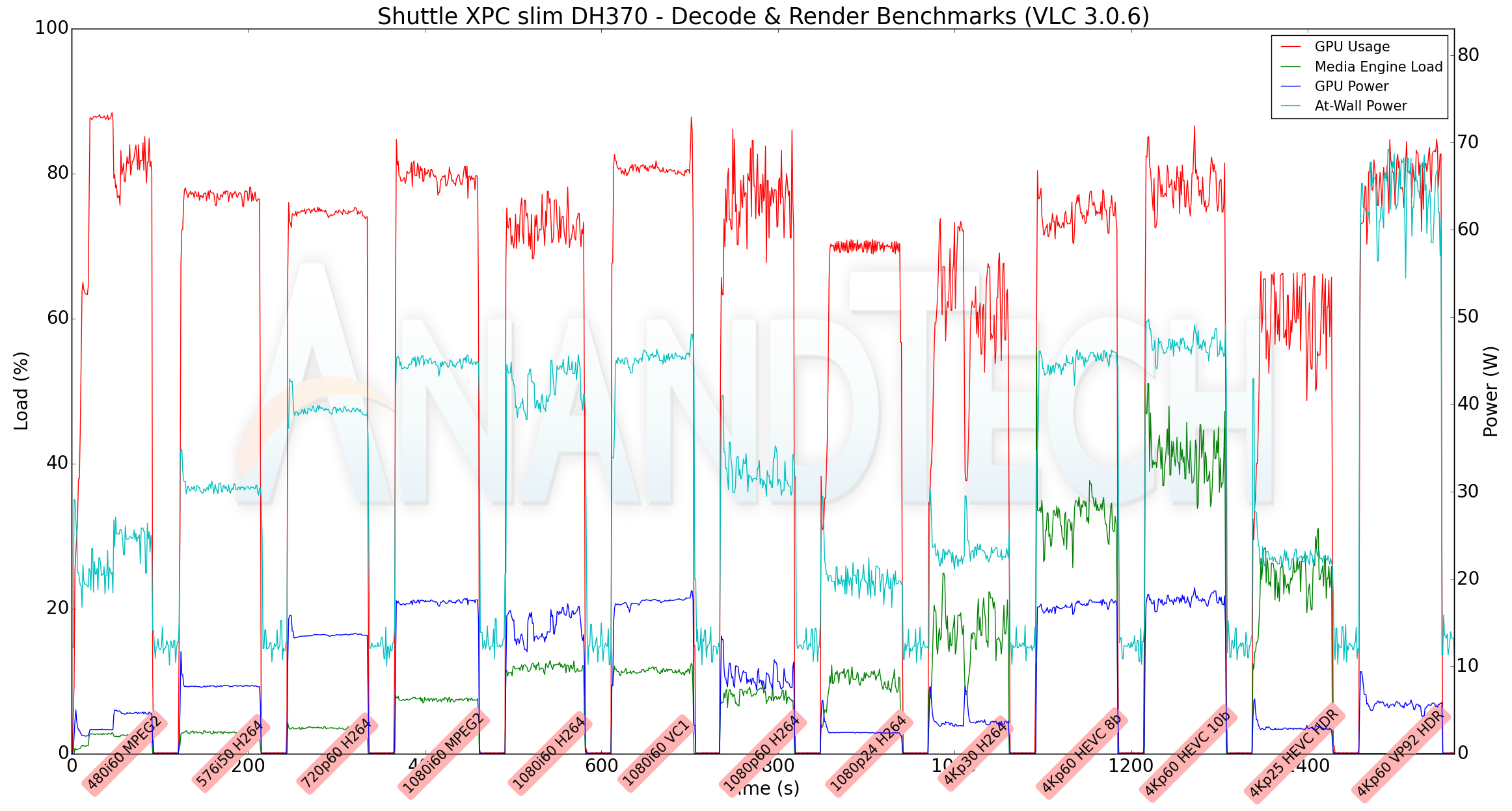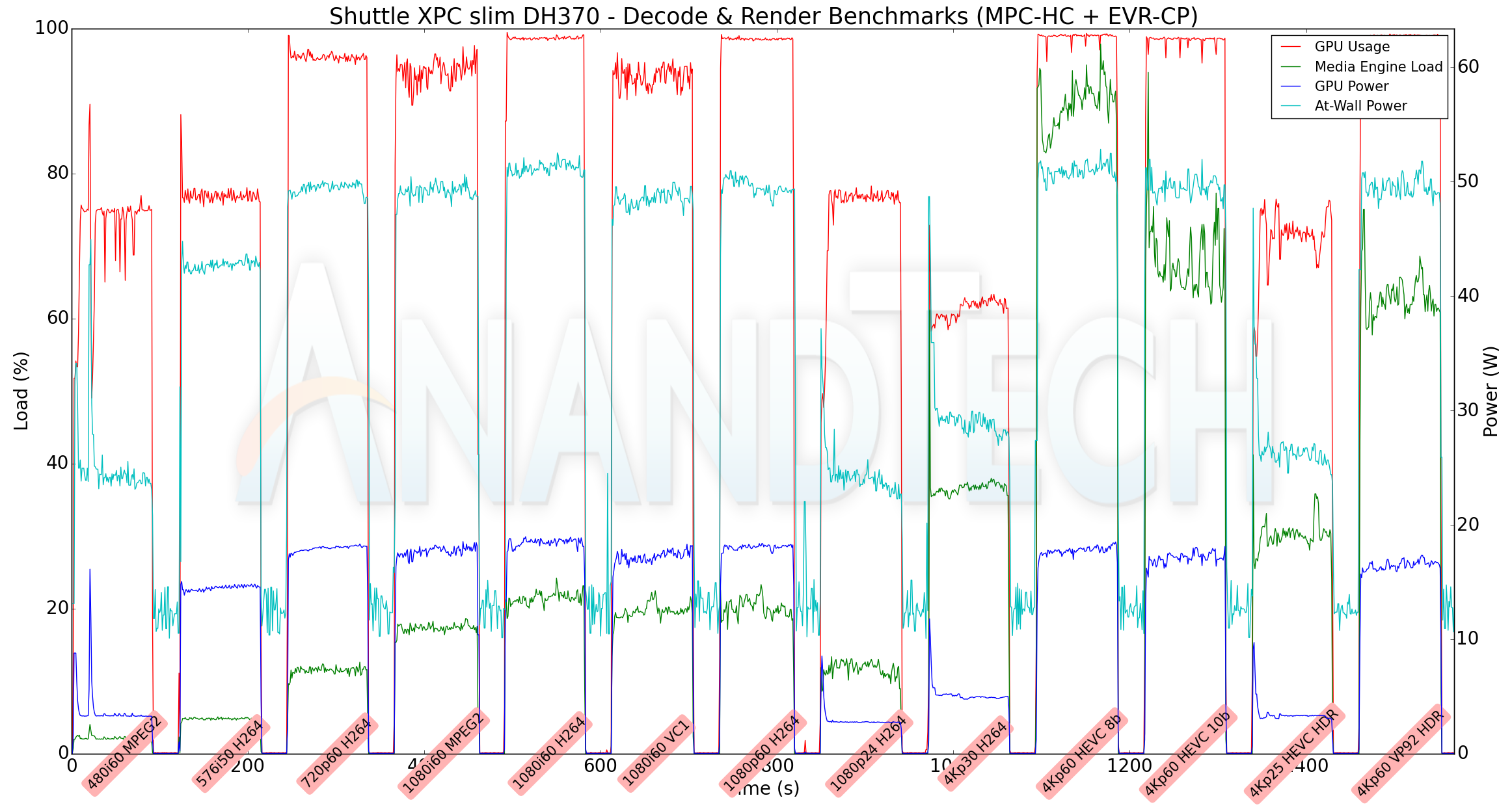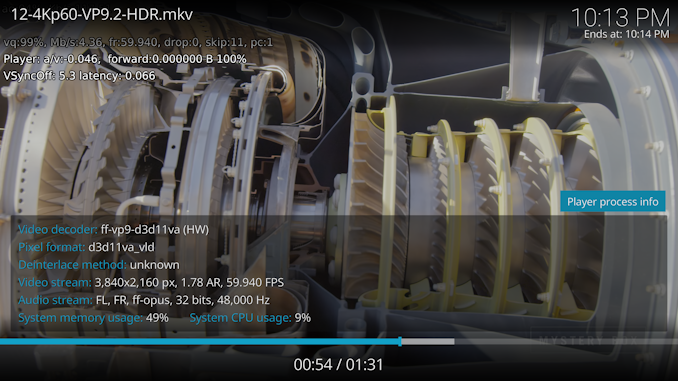Shuttle XPC slim DH370 mini-PC Review: A Compact Digital Signage Powerhouse
by Ganesh T S on May 6, 2019 8:00 AM ESTHTPC Credentials - Local Media Playback and Video Processing
Evaluation of local media playback and video processing is done by playing back files encompassing a range of relevant codecs, containers, resolutions, and frame rates. A note of the efficiency is also made by tracking GPU usage and power consumption of the system at the wall. Users have their own preference for the playback software / decoder / renderer, and our aim is to have numbers representative of commonly encountered scenarios. Towards this, we played back the test streams using the following combinations:
- MPC-HC x64 1.8.5 + LAV Video Decoder (DXVA2 Native) + Enhanced Video Renderer - Custom Presenter (EVR-CP)
- MPC-HC x64 1.8.5 + LAV Video Decoder (D3D11) + madVR 0.92.17 (DXVA-Focused)
- MPC-HC x64 1.8.5 + LAV Video Decoder (D3D11) + madVR 0.92.17 (Lanczos-Focused)
- VLC 3.0.6
- Kodi 18.1
The thirteen test streams (each of 90s duration) were played back from the local disk with an interval of 30 seconds in-between. Various metrics including GPU usage and at-wall power consumption were recorded during the course of this playback. Prior to looking at the metrics, a quick summary of the decoding capabilities of the Intel UHD Graphics 630 is useful to have for context.
The GPU can provide hardware acceleration for all contemporary codecs.
All our playback tests were done with the desktop HDR setting turned on. It is possible for certain system configurations to have madVR automatically turn on/off the HDR capabilities prior to the playback of a HDR video, but, we didn't take advantage of that in our testing.
VLC and Kodi
VLC is the playback software of choice for the average PC user who doesn't need a ten-foot UI. Its install-and-play simplicity has made it extremely popular. Over the years, the software has gained the ability to take advantage of various hardware acceleration options. Kodi, on the other hand, has a ten-foot UI making it the perfect open-source software for dedicated HTPCs. Support for add-ons make it very extensible and capable of customization. We played back our test files using the default VLC and Kodi configurations, and recorded the following metrics.
| Video Playback Efficiency - VLC and Kodi | |||

VLC is able to play back all streams with hardware acceleration - GPU usage less than 80% and media engine load less than 40% - except for the VP9 Profile 2 video. At-wall power consumption ranges from around 20W for the 1080p24 H.264 stream to 45W for the 4Kp60 HEVC streams. In the software decode case, we have the at-wall number sooting up to 65W. Kodi 18.1, on the other hand, is uniformly good. All streams, including the VP9.2 one, are played back with hardware acceleration and no dropped frames.
The GPU and media engine usage do not cross 80% for any of the files. The at-wall power consumption is around 28W - 32W depending on the stream/
MPC-HC
MPC-HC offers an easy way to test out different combinations of decoders and renderers. The first configuration we evaluated is the default post-install scenario, with only the in-built LAV Video Decoder forced to DXVA2 Native mode. Two additional passes were done with different madVR configurations. In the first one (DXVA-focused), we configured madVR to make use of the DXVA-accelerated video processing capabilities as much as possible. In the second (Lanczos-focused), the image scaling algorithms were set to 'Lanczos 3-tap, with anti-ringing checked'. Chroma upscaling was configured to be 'BiCubic 75 with anti-ringing checked' in both cases. The metrics collected during the playback of the test files using the above three configurations are presented below.
| Video Playback Efficiency - MPC-HC with EVR-CP and madVR | |||

The experience with MPC-HC and the latest Intel drivers (v6709) couldn't be more starkly different from what we experienced with the Bean Canyon NUC. The VP9 Profile 2 stream apparently plays back with hardware acceleration, but, suffers from plenty of dropped frames. The GPU power consumption numbers also seem off-the-charts, compared to what we saw with Kodi. This translates to higher at-wall power consumption in the 50W range even for streams that are decoded with hardware acceleration. Given this state with the lean EVR-CP renderer, the less said about the madVR configurations, the better.
Overall, Kodi 18.1 turned out to be the perfect media player application for use in the Shuttle XPC slim DH370.












37 Comments
View All Comments
mikato - Tuesday, May 7, 2019 - link
Don't get me wrong, I would like that too. SilentPCReview.com needs to be revived perhaps. They, and their community, were the best. People lost interest I guess once storage drives, power supplies, retail computers, even GPUs improved noise by a lot. Plus other reviewers started paying attention to noise partly through their work. But with mini PCs and HTPCs maybe there is renewed thirst for noise analysis.The issue may be - how does Ganesh prevent outside factors and just the changing ambient noise level from influencing noise measurements? He would need some type of anechoic chamber and probably some audio equipment. Read this to see what goes into it, for removing outside influence and actually having a low enough ambient noise level for meaningful measurements - http://www.silentpcreview.com/anechoic_chamber_SPC...
Then there are logistics issues. Will Anandtech pay for or provide what may be needed? Does he do review work at his house/apartment? Is there an Anandtech central office? Do other Anandtech reviewers mostly live in the same area? Can someone rent an anechoic chamber? Keep in mind SPCR was mostly one guy on a mission, while Anandtech and Ganesh have plenty of other concerns.
Is there a spot in the middle where noise measurements are "good enough"? Any ideas? I do see noise measurements at other review sites sometimes, but I don't know if they are good enough for comparing among different product reviews that took place at different times and possibly at different places.
GDVX_111 - Monday, June 13, 2022 - link
This query comes 3 years later, so I know that the odds on a response are not good, but WHICH existing Shuttle model is going to have more than adequate HTPC chops and features, as well as the desired quietness, heat dissipation, and reliability characteristics ? (Regardless of price, even.) I say existing model because I like Shuttle, and I don't care to build something from scratch out of disparate parts that may be available. The SH67H3 cube that still serves as my desktop computer would certainly fill the bill, and is plenty quiet even a few inches away on my desk, but of course it is several times the size and would require space I don't have in either of my video stacks.Another design factor that struck me as being perhaps dubious in these more compact, digital kiosk or signage oriented models has been the move to outboard power bricks, rather than an integrated PSU. But perhaps that is unavoidable, given the compact size.
bill44 - Monday, May 6, 2019 - link
How about 3D BD ISO playback?Does it use LSPCon for HDMI?
timecop1818 - Monday, May 6, 2019 - link
Yes, it uses MegaChips MCDP2850 to convert DisplayPort to HDMI 2.0. You can see it on the motherboard photo in the QuickStart manual. What about 3D BD ISO playback? Why wouldn't that work?ganeshts - Monday, May 6, 2019 - link
3D is usually not supported if you have a LSPcon. I have reason to believe 3D is not supported over the HDMI 2.0a ports in the last two Intel platform generations.With the advent of 4K and HDR, the industry has got much more convincing features to make people upgrade their equipment (compared to 3D). Effectively, 3D is dead from an industry viewpoint. YMMV.
Opencg - Monday, May 6, 2019 - link
great example of a tech killed off by lack of content (i mean good content). too many movies were simply reprocessed without being produced from the ground up with the intent of 3d. the industry tried to charge a premuim for lackluster content with hardware implementations having support and quality issues. not to mention some big problems like focal blur guessing.i really hope vr doesnt go the route of 3d games and 3d movies. but yeah people dont seem to understand that the most important things are affordability and minimizing barriers to entry. also not having an industry clinging to ancient monitization practices helps.
Death666Angel - Monday, May 6, 2019 - link
I think it is more about the technology itself. In order for stereoscopic 3D to work well, you need to have most of your field of vision filled by the content. That is easily done in a cinema, where the screen is huge and the ambient lights are darkened and everyone is fine with that. At home, most people I know have their setup with a small TV (37" to 50") and it is in a corner somewhere it makes sense but is out of the way (since the TV may be on a lot, but hardly watched focused most of the time). Only some die hard movie people (like myself) have a large TV (55"+, preferably 65"+) that is not too far away from the main sitting position (couch). But even then, it is a bit too small for 3D to work well and immerse myself in it and I can't really darken everything down as much as in the cinema. And I have never had comfortable 3D glasses. They always either hurt my sides or my nose.VR won't go away as 3D will, since it has a much larger impact in the professional world (engineering, architecture, medicine, art...), but home VR has an uphill battle to fight still.
0ldman79 - Tuesday, May 7, 2019 - link
Honestly I'm kind of expecting 3D to come back again.They are now making fully transparent TVs.
Layer the screens and you can have actual 3D (at least two layers of depth) without glasses.
Death666Angel - Tuesday, May 7, 2019 - link
How would that work? You still need a way to block one eye from seeing the content the other eye sees. Doing it with a parallax barrier requires cost and doesn't work for more than one person without a lot of complications (which increase price, a lot). You also lose resolution compared to full 3D SBS and active shutter glasses.Or do you just mean 3D in a diorama way where you have discreet layers of content? That is not 3D.
bill44 - Monday, May 6, 2019 - link
Thanks ganeshts.I know it's a dead format, but I would like to use it as long as my TV lasts.
Hoping one day I can get a modern PC that has native HDMI ports (no LSPCon).
Does anyone know of TB3->HDMI adapter/cable that does work?